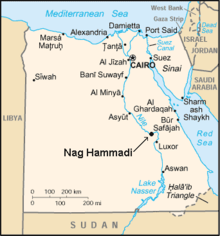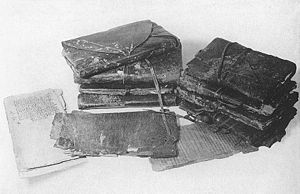- Nag Hammadi library
-
The Nag Hammadi library[1] is a collection of early Christian Gnostic texts discovered near the Upper Egyptian town of Nag Hammadi in 1945. That year, twelve leather-bound papyrus codices buried in a sealed jar were found by a local peasant named Mohammed Ali Samman.[2][3] The writings in these codices comprised fifty-two mostly Gnostic treatises, but they also include three works belonging to the Corpus Hermeticum and a partial translation/alteration of Plato's Republic. In his "Introduction" to The Nag Hammadi Library in English, James Robinson suggests that these codices may have belonged to a nearby Pachomian monastery, and were buried after Bishop Athanasius condemned the uncritical use of non-canonical books in his Festal Letter of 367AD.
The contents of the codices were written in the Coptic language, though the works were probably all translations from Greek.[4] The best-known of these works is probably the Gospel of Thomas, of which the Nag Hammadi codices contain the only complete text. After the discovery it was recognized that fragments of these sayings attributed to Jesus appeared in manuscripts discovered at Oxyrhynchus in 1898 (P. Oxy. 1), and matching quotations were recognized in other early Christian sources. Subsequently, a 1st or 2nd century date of composition circa 80 AD for the lost Greek originals of the Gospel of Thomas has been proposed, The buried manuscripts themselves date from the 3rd and 4th centuries.
The Nag Hammadi codices are housed in the Coptic Museum in Cairo, Egypt. To read about their significance to modern scholarship into early Christianity, see the Gnosticism article.
Contents
Discovery at Nag Hammadi
 The site of discovery, Nag Hammadi in map of Egypt
The site of discovery, Nag Hammadi in map of Egypt
Gnosticism 
This article is part of a series on GnosticismHistory of Gnosticism Early Gnosticism Syrian-Egyptic Gnosticism Gnosticism in modern times Proto-Gnostics Philo Simon Magus Cerinthus Valentinus Basilides Gnostic texts Gnostic Gospels Nag Hammadi library Codex Tchacos Askew Codex Bruce Codex Gnosticism and the New Testament Related articles Gnosis Neoplatonism and Gnosticism Mandaeism Manichaeism Bosnian Church Esoteric Christianity Jnana
Gnosticism Portal
The story of the discovery of the Nag Hammadi library in 1945 has been described as 'exciting as the contents of the find itself'.[5] In December of that year, two Egyptian brothers found several papyri in a large earthenware vessel while digging for fertilizer around the Jabal al-Ṭārif caves near present-day Hamra Dom in Upper Egypt. The find was not initially reported by either of the brothers, who sought to make money from the manuscripts by selling them individually at intervals. It is also reported that the brothers' mother burned several of the manuscripts, worried, apparently, that the papers might have 'dangerous effects' (Markschies, Gnosis, 48). As a result, what came to be known as the Nag Hammadi library (owing to the proximity of the find to Nag Hammadi, the nearest major settlement) appeared only gradually, and its significance went unacknowledged until some time after its initial uncovering.
In 1946, the brothers became involved in a feud, and left the manuscripts with a Coptic priest, whose brother-in-law in October that year sold a codex to the Coptic Museum in Old Cairo (this tract is today numbered Codex III in the collection). The resident Coptologist and religious historian Jean Doresse, realizing the significance of the artifact, published the first reference to it in 1948. Over the years, most of the tracts were passed by the priest to a Cypriot antiques dealer in Cairo, thereafter being retained by the Department of Antiquities, for fear that they would be sold out of the country. After the revolution in 1952, these texts were handed to the Coptic Museum in Cairo, and declared national property.[6] Pahor Labib, the director of the Coptic Museum at that time, was keen to keep these manuscripts in their country of origin.
Meanwhile, a single codex had been sold in Cairo to a Belgian antique dealer. After an attempt was made to sell the codex in both New York and Paris, it was acquired by the Carl Gustav Jung Institute in Zurich in 1951, through the mediation of Gilles Quispel. There it was intended as a birthday present to the famous psychologist; for this reason, this codex is typically known as the Jung Codex, being Codex I in the collection.[6]
Jung's death in 1961 caused a quarrel over the ownership of the Jung Codex, with the result that the pages were not given to the Coptic Museum in Cairo until 1975, after a first edition of the text had been published. Thus the papyri were finally brought together in Cairo: of the 1945 find, eleven complete books and fragments of two others, 'amounting to well over 1000 written pages' are preserved there.[7]
Translation
The first edition of a text found at Nag Hammadi was from the Jung Codex, a partial translation of which appeared in Cairo in 1956, and a single extensive facsimile edition was planned. Due to the difficult political circumstances in Egypt, individual tracts followed from the Cairo and Zurich collections only slowly.
This state of affairs changed only in 1966, with the holding of the Messina Congress in Italy. At this conference, intended to allow scholars to arrive at a group consensus concerning the definition of gnosticism, James M. Robinson, an expert on religion, assembled a group of editors and translators whose express task was to publish a bilingual edition of the Nag Hammadi codices in English, in collaboration with the Institute for Antiquity and Christianity at the Claremont Graduate University in Claremont, California. Robinson had been elected secretary of the International Committee for the Nag Hammadi Codices, which had been formed in 1970 by UNESCO and the Egyptian Ministry of Culture; it was in this capacity that he oversaw the project. In the meantime, a facsimile edition in twelve volumes did appear between 1972 and 1977, with subsequent additions in 1979 and 1984 from publisher E.J. Brill in Leiden, called The Facsimile Edition of the Nag Hammadi Codices, making the whole find available for all interested parties to study in some form.
At the same time, in the German Democratic Republic a group of scholars—including Alexander Bohlig, Martin Krause and New Testament scholars Gesine Schenke, Hans-Martin Schenke and Hans-Gebhard Bethge--were preparing the first German language translation of the find. The last three scholars prepared a complete scholarly translation under the auspices of the Berlin Humboldt University, which was published in 2001.
The James M. Robinson translation was first published in 1977, with the name The Nag Hammadi Library in English, in collaboration between E.J. Brill and Harper & Row. The single-volume publication, according to Robinson, 'marked the end of one stage of Nag Hammadi scholarship and the beginning of another' (from the Preface to the third revised edition). Paperback editions followed in 1981 and 1984, from E.J. Brill and Harper respectively. A third, completely revised edition was published in 1988. This marks the final stage in the gradual dispersal of gnostic texts into the wider public arena—the full complement of codices was finally available in unadulterated form to people around the world, in a variety of languages.
A further English edition was published in 1987, by Yale scholar Bentley Layton, called The Gnostic Scriptures: A New Translation with Annotations (Garden City: Doubleday & Co., 1987). The volume unified new translations from the Nag Hammadi Library with extracts from the heresiological writers, and other gnostic material. It remains, along with The Nag Hammadi Library in English one of the more accessible volumes translating the Nag Hammadi find, with extensive historical introductions to individual gnostic groups, notes on translation, annotations to the text and the organization of tracts into clearly defined movements.
Not all scholars, however, agree that the entire library should be considered Gnostic. Paterson Brown has argued forcefully that the three Nag Hammadi Gospels of Thomas, Philip and Truth cannot be so labeled, since each explicitly affirms the basic reality and sanctity of incarnate life, which Gnosticism by definition considers illusory or evil: 'Are the Coptic Gospels Gnostic?'.[8]
Complete list of codices found in Nag Hammadi
- Codex I (also known as The Jung Foundation Codex):
- The Prayer of the Apostle Paul
- The Apocryphon of James (also known as the Secret Book of James)
- The Gospel of Truth
- The Treatise on the Resurrection
- The Tripartite Tractate
- Codex II:
- The Apocryphon of John
- The Gospel of Thomas a sayings gospel
- The Gospel of Philip
- The Hypostasis of the Archons
- On the Origin of the World
- The Exegesis on the Soul
- The Book of Thomas the Contender
- Codex III:
- Codex IV:
- Codex V:
- Codex VI:
- The Acts of Peter and the Twelve Apostles
- The Thunder, Perfect Mind
- Authoritative Teaching
- The Concept of Our Great Power
- Republic by Plato - The original is not gnostic, but the Nag Hammadi library version is heavily modified with then-current gnostic concepts.
- The Discourse on the Eighth and Ninth - a Hermetic treatise
- The Prayer of Thanksgiving (with a hand-written note) - a Hermetic prayer
- Asclepius 21-29 - another Hermetic treatise
- Codex VII:
- Codex VIII:
- Codex IX:
- Codex X:
- Codex XI:
- The Interpretation of Knowledge
- A Valentinian Exposition, On the Anointing, On Baptism (A and B) and On the Eucharist (A and B)
- Allogenes
- Hypsiphrone
- Codex XII
- The Sentences of Sextus
- The Gospel of Truth
- Fragments
- Codex XIII:
- Trimorphic Protennoia
- On the Origin of the World
The so-called "Codex XIII" is in fact not a codex, but rather the text of Trimorphic Protennoia, written on "... eight leaves removed from a thirteenth book in late antiquity and tucked inside the front cover of the sixth." (Robinson, NHLE, p. 10) Only a few lines from the beginning of Origin of the World are discernible on the bottom of the eighth leaf.
See also
- Apocalyptic literature
- Acts of the Apostles (genre)
- Agrapha
- Biblical archaeology
- Development of the New Testament canon
- Epistles
- Gnosticism
- Gospel of Mary Magdalene
- List of Gospels
- List of New Testament papyri
- New Testament apocrypha
- Pseudepigraphy
- Textual criticism
Further reading
- Layton, Bentley (1987). The Gnostic Scriptures. SCM Press. ISBN 0-334-02022-0. (526 pages)
- Markschies, Christoph (trans. John Bowden), (2000). Gnosis: An Introduction. T & T Clark. ISBN 0-567-08945-2. (145 pages)
- Pagels, Elaine (1979). The Gnostic Gospels. ISBN 0-679-72453-2. (182 pages)
- Robinson, James (1988). The Nag Hammadi Library in English. ISBN 0-06-066934-9. (549 pages)
- Robinson, James M., 1979 "The discovery of the Nag Hammadi codices," in Biblical Archaeology vol. 42, pp206–224.
Notes and references
- ^ Sometimes popularly known as the Gnostic Gospels after Elaine Pagels' 1979 book of the same name, but the term has a wider meaning.
- ^ The Nag Hammadi Library: The Minor History Behind a Major Discovery
- ^ Marvin Meyer and James M. Robinson, Nag Hammadi Scriptures, The: The International Edition. HarperOne, 2007. pp 2-3. ISBN 0-06-052378-6
- ^ Robinson, James M., The Nag Hammadi Library, HarperCollins, 1988, p.2
- ^ (Markschies, Gnosis: An Introduction, 48).
- ^ a b Robinson, James M. ed., The Nag Hammadi Library, revised edition. HarperCollins, San Francisco, 1990.
- ^ (Markschies, Gnosis: An Introduction, 49)
- ^ Essay on the Ecumenical Coptic Project website, from which the requisite Coptic font may be downloaded.
External links
- The Nag Hammadi Library Complete texts at The Gnostic Society Library
- The Gospel of Thomas Multiple translations and resources.
- The Nag Hammadi Library
- How the manuscripts were found
Categories: - Codex I (also known as The Jung Foundation Codex):
Wikimedia Foundation. 2010.

